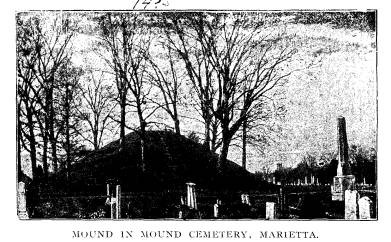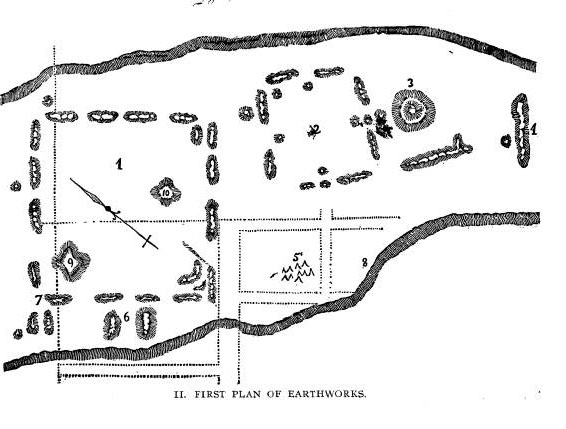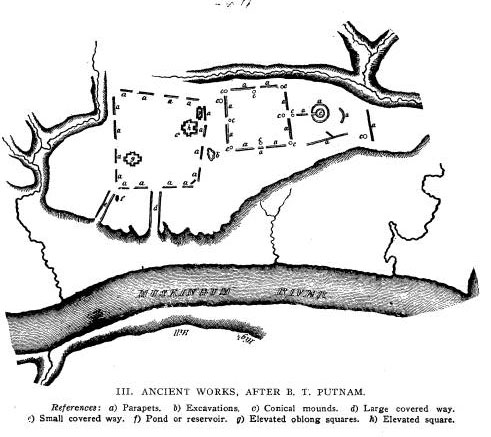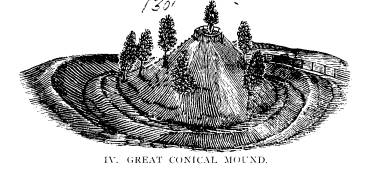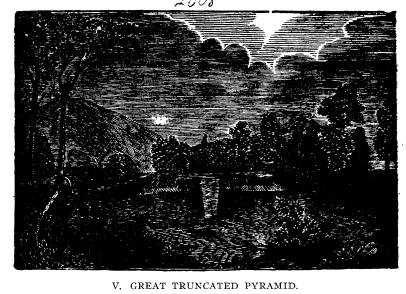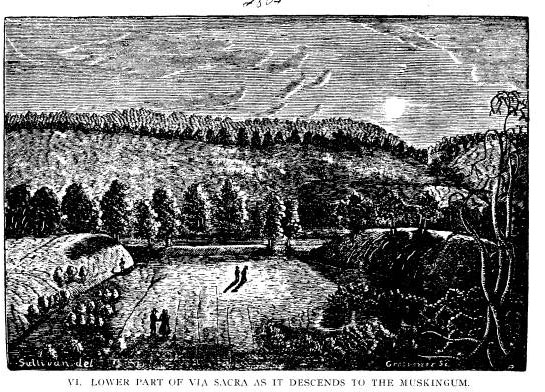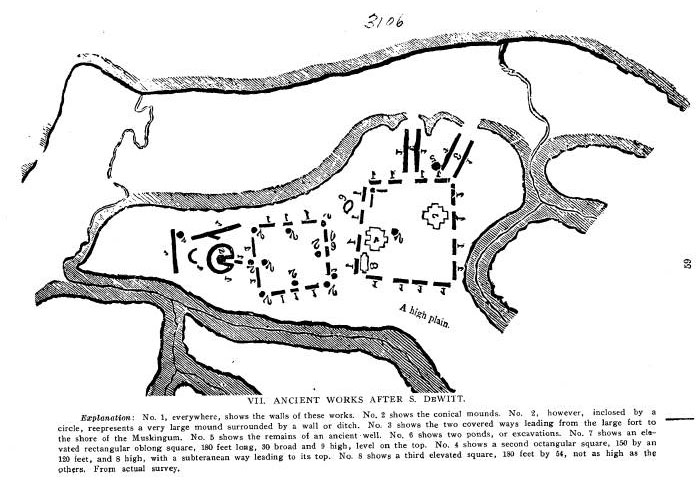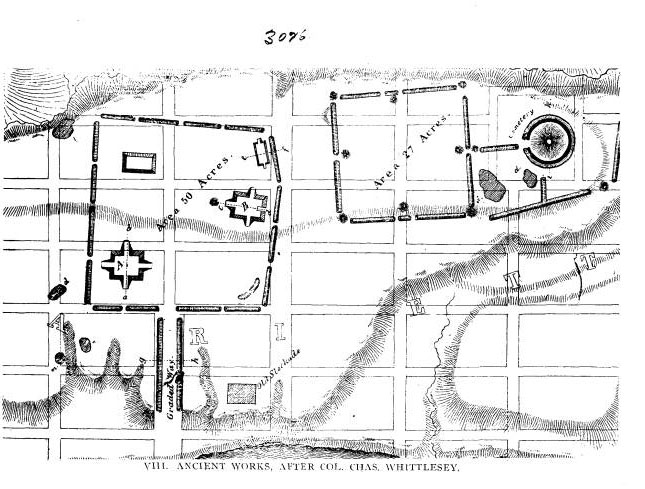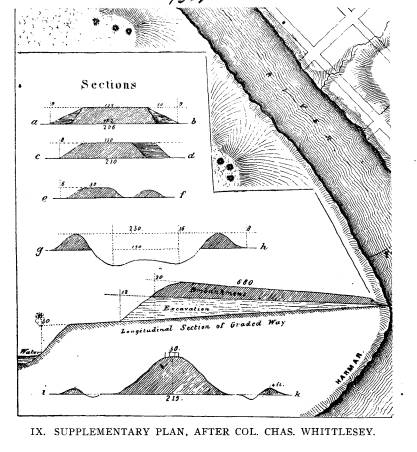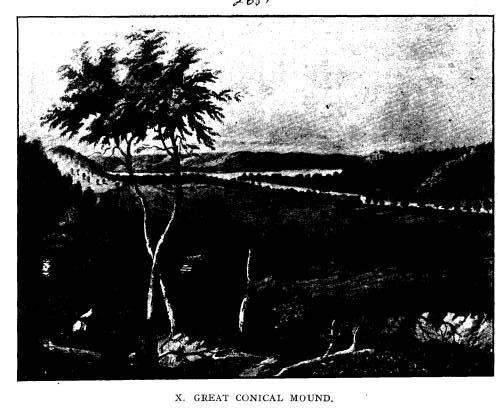Ohio History Journal
- 1
- 2
- 3
- 4
- 5
- 6
- 7
- 8
- 9
- 10
- 11
- 12
- 13
- 14
- 15
- 16
- 17
- 18
- 19
- 20
- 21
- 22
- 23
- 24
- 25
- 26
- 27
- 28
- 29
- 30
ANCIENT WORKS AT MARIETTA, OHIO.
BY J. P. MACLEAN, PH. D.
The ancient earthworks at Marietta,
Ohio, have received
much attention, and have been written
about more than any of
the prehistoric remains of the Ohio and
Mississippi valleys.
These structures were great and ranked
high in importance, al-
though not so extensive and complicated
as certain other remains
which have been fully considered. At the
time of the opening of
the great West the Ohio river was the
main artery that led into
the wilderness, and hence the Marietta
antiquities invited early
notice; but the first to be recorded
were those at Circleville.
Rev. David Jones, of Freehold, New
Jersey, in 1772-3, spent
some time among the western Indians, and
in his journal makes
mention of some of the works on the
Scioto. On October 17,
1772, he made a plan and computation of
the works at Circleville.
The company of settlers, organized by
Gen. Rufus Putnam,
arrived at the mouth of the Muskingum
April 7, 1788, and then
took possession of the land purchased of
the United States Gov-
ernment. The Directors of the company,
appreciating the im-
portance of the ancient remains, took
immediate measures for
their preservation. One of their
earliest official acts was the
passage of a resolution, which they
caused to be entered upon
the journal of their proceedings,
reserving the two truncated
pyramids and the great conical mound,
with a few acres attached
to each, as public squares. The great
avenue, named "Sacra
Via," by special resolution was
"never to be disturbed or de-
faced, as common ground, not to be
enclosed." These works
were placed under the care of the
corporation of Marietta, with
the direction that they should be
embellished with shade trees
of native growth, the varieties of which
being specified.
It is of no credit to the people of
Marietta to examine into
the cause of their falseness to their
trust. When I visited these
works in 1882, I found the truncated
pyramids denuded and
the walls of the Sacra Via gone. On
inquiring what had become
(37)
|
38 Ohio Arch. and His. Society Publications.
of these walls I was informed that the material had been moulded into brick; that a brick-maker had been elected a member of the town council, and he had persuaded the other members to vote to sell him the walls. This unpleasant fact has also been reported by Prof. Wright. Quite a voluminous report of the Centennial Celebration of Marietta is given in volume II, OHIO ARCHAEOLOGICAL AND HISTORICAL QUARTERLY, replete with ora- tory and glorification, but no word concerning what has really made Marietta known. The editor of the QUARTERLY, more con- siderate, accompanies the account with a cut of the remains, taken |
|
|
|
from Squier & Davis' "Ancient Monuments," and an original picture of the conical mound in the cemetery. With but little exaggeration it may be stated the antiquities at Marietta are principally obliterated. What few remain do not exhibit the value of what existed at the time the Ohio Com- pany took possession. For all archaeological purposes we must depend on the integrity of those who made surveys and plans of the works when they were practically complete. Fortunately we are not at a loss in this matter. The works were of sufficient note, not only to call the attention of military men and travellers, but also to excite the curiosity of the intelligent in the older states. The descriptions and plans of these early observers have |
Ancient Works at Marietta, Ohio. 39
been preserved. The changes that have
taken place in the con-
dition of these structures, and the
variations noted by the dif-
ferent observers, all point to value in
summing up the evidence.
When the works were denuded of their
trees and the iconoclastic
hand of the white man protruded itself,
the change in the appear-
ance of the remains must have been very
rapid.
EARLY NOTICES.
In all probability the first of the
ancient earthworks west
of the Alleghanies that were carefully
surveyed were those under
consideration. During the years 1785 and
1786 many letters
from army officers found their way into
the public prints giving
an account of these remains, some of
which were highly exagger-
ated. It was due to Gen. Samuel H.
Parsons, that an authentic
character should be given to the
reports. In a letter addressed
to President Willard, of Harvard
College, dated October 2, 1786,
he described the Grave Creek mound -
Moundsville, W. Va. -
and referred to the remains at Marietta,
a description of which
he had sent previously to President
Stiles, of New Haven.
The first plan and description of the
works have been ascribed
to Capt. Jonathan Heart. General Harmar,
in a letter dated Fort
Pitt, March 17, 1787, to General
Thomas Mifflin, of Philadelphia,
says: "Be pleased to view the
inclosed plan of the remains of
some ancient works on the Muskingum,
taken by a captain of
mine (Heart), with his explanations.
Various are the con-
jectures concerning these
fortifications. From their regularity
I conceive them to be the works of some
civilized people. Who
they were I know not. Certain it is, the
present race of savages
are strangers to anything of the
kind." *
Daniel Stebbens states,+ under date of
Northampton, Mass.,
May 1842, that the drawing sent to Dr. Stiles, was copied by
him, to be preserved in the archives of
Yale College. In his
letter he explains the drawing.
"No. I, Town. No. 2, The Fort.
No. 3, The Great Mound and Ditch. No. 4,
The Advance Work.
No. 5, Indian Graves. No. 6, Covered Way
from the town to
the then locality of the river, which is
supposed at that time to
* Butterfield's Journal of Captain
Jonathan Heart, p XIII.
+ American Pioneer, Vol I, p. 339.
Ancient Works at Marietta, Ohio. 41
have run along the edge of the second
bottom. These walls are
now twenty feet high, and the graded
road between them was
one hundred feet wide, and beautifully
rounded like a modern
turnpike. No. 7, A Second Covered Way
with walls of less
elevation. No. 8, Caves. Nos. 9 and 10, Elevated Squares.
These works were interspersed with many
small mounds as repre-
sented in the drawings."
The Columbian Magazine, for May 1789,
contains Capt.
Heart's plan with an elaborate
description.
The Pennsylvania Gazette, October 22, 1788, contains
a
letter from a gentleman at Marietta, to
his friend in Massachu-
setts, dated September 8, 1788, from
which the following is ex-
tracted: "An accurate survey of the
ancient ruins within the
limits of our city has been made in
presence of the governor,
judges, directors of the company, and a
number of other gentle-
men, that we may be able to ascertain
all the facts respecting
them; in the course of this survey we
had several of the large
trees, on the parapet of those works,
cut down, and have examined
their ages by the rings of grains from
the heart to the surface,
computing each grain to be one year's
growth. We found
one tree to have stood 443 years,
another 289, situated so as to
leave no room to doubt of their having
began to grow since those
works were abandoned. We find the
perpendicular height of
the walls of this covert to be at this
time twenty feet and the
base thirty-nine, the width twelve
rods."++
In the third volume of the American
Philosophical Society,
appears Captain Heart's replies to
inquiries, which he wrote in
January 1791. In this paper he treats
the subject in a judicious
manner observing "that the state of
the works and the trees grow-
ing on them indicated an origin prior to
the discovery of America
by Columbus; that they were not due to
the present Indians or
their predecessors, or some tradition
would have remained of
their uses; that they were not
constructed by a people who pro-
cured the necessaries of life by
hunting, as a sufficient number
to carry on such labors could not have
subsisted in that way;
and, lastly, that the people who
constructed them were not alto-
gether in an uncivilized state, as they
must have been under the
* Journal and Letters of Colonel John May, p. 58.
42 Ohio Arch. and His.
Society Publications.
subordination of law, with a strict and
well-governed police, or
they could not have been kept together
in such numerous bodies,
and been made to contribute to the
execution of such stupendous
works."*
It was most unfortunate that two such
intelligent observers
as Gen. Parsons and Capt. Heart should
meet with death so soon
after their interest in western
antiquities had been awakened.
The former was drowned in the Ohio river
in December 1791,
and the latter was slain in the
disastrous defeat of St. Clair, in
November 1791, while, with a handful of
men, he was covering
the retreat of the army.
Col. Winthrop Sargent, in March, 1787,
wrote a more
elaborate and finished sketch than that
of Capt. Heart, and sent
it to Governor Bowdoin, which was not
published until 1853,
when it appeared in "Memoirs
American Academy of Arts and
Sciences."
DESCRIPTION BY HARRIS.
In the year 1803, Rev. Dr. Thaddeus M. Harris,
of Massa-
chusetts, examined some of the ancient
structures, and published
his "Journal of a Tour" in 1805. The following
is the oft
repeated description taken from his book
(Page 149) : "The situ-
ation of these works is on an elevated
plain, above the present
bank of the Muskingum, on the east side,
and about half a mile
from
its junction with the Ohio. They consist of walls and
mounds of earth, in direct lines, and in
square and circular forms.
The largest square fort, by some called
the town, contains
forty acres, encompassed by a wall of
earth, from six to ten feet
high, and from twenty-five to thirty-six
in breadth at the base.
On each side are three openings, at
equal distances, resembling
twelve gateways. The entrances at the
middle, are the largest,
particularly on the side next to the
Muskingum. From this out-
let is a covert way, formed of two
parellel walls of earth, two
hundred and thirty-one feet distant from
each other, measuring
from center to center. The walls at the
most elevated part, on
the inside, are twenty-one feet in
height, and forty-two in breadth
at the base, but on the outside average
only five feet in height.
* Haven's Archaeology of the United
States, p. 24.
Ancient Works at Marietta, Ohio. 43
This forms a passage of about three
hundred and sixty feet in
length, leading by a gradual descent to
the low grounds, where
at the time of its construction, it
probably reached the river.
Its walls commence at sixty feet from
the ramparts of the fort,
and increase in elevation as the way
descends towards the river;
and the bottom is crowned in the center,
in the manner of a well
founded turnpike road.
Within the walls of the fort, at the northwest
corner, is an
oblong elevated square, one hundred and
eighty-eight feet long,
one hundred and thirty-two broad, and
nine feet high; leve on
the summit, and nearly perpendicular at
the sides. At the center
of each of the sides, the earth is
projected, forming gradual
ascents to the top, equally regular, and
about six feet in width.
Near the south wall is another elevated
square, one hundred and
fifty feet by one hundred and twenty,
and eight feet high, similar
to the other, excepting that instead of
an ascent to go up on the
side next to the wall, there is a hollow
way ten feet wide, leading
twenty feet towards the center, and then
rising with a gradual
slope to the top. At the southeast
corner, is a third elevated
square, one hundred and eight, by
fifty-four feet, with ascents
at the ends, but not so high nor perfect
as the two others. A
little to the southwest of the center of
the fort is a circular
mound, about thirty feet in diameter and
five feet high, near
which are four small excavations at
equal distances, and opposite
each other. At the southwest corner of
the fort is a semicircular
parapet, crowned with a mound, which
guards the opening in
the wall. Towards the southeast is a
smaller fort, containing
twenty acres, with a gateway in the
center of each side and at
each corner. These gateways are defended
by circular mounds.
On the outside of the smaller fort is a
mound, in form of a
sugar loaf, of a magnitude and height
which strikes the beholder
with astonishment. Its base is a regular
circle, one hundred and
fifteen feet in diameter; its
perpendicular altitude is thirty feet.
It is surrounded by a ditch four feet
deep and fifteen feet wide,
and defended by a parapet four feet
high, through which is a
gateway towards the fort, twenty feet in
width. There are other
walls, mounds, and excavations, less
conspicuous and entire."
44 Ohio Arch. and His. Society Publications.
Mr. Harris adopted from Clavigero his
account of the emi-
gration of the Toltecs, and to them
ascribed the construction of
all similar works, and maintained that
the mural works had been
surmounted by palisades, intended for
protection in the gradual
progress made by these people through
the territories of less
civilized tribes.
OPINIONS OF JAMES MADISON.
At the same time Mr. Harris was engaged
in making his
observations on one side of the Ohio
river, on the other, James
Madison, then episcopal bishop of
Virginia, was likewise enter-
taining himself. The result of his
observations he communicated
in a letter which was read before the
Philosophical Society, and
subsequently appeared in one of its
volumes. It appeared to
Bishop Madison that such remains were
too numerous and vari-
ous in form, besides being too
unfavorably situated to be re-
garded as places of defence; and their
striking figures indicated
one common origin and destination. He
regarded the mounds as
burial places.
ATWATER'S SURVEY.
At the request of the President of the
American Anti-
quarian Society, and by him assisted
with pecuniary means, Caleb
Atwater undertook to prepare a
comprehensive account of the
antiquities of the Western States. This
contribution was pub-
lished by the society in 1820, and comprises
164 pages of Vol.
I. of its Transactions. Seven pages are
devoted to the Marietta
works. The text is accompanied by a plan
taken from a survey
made by B. P. Putnam.
The contribution, with accompanying
plates, was republished
by the author, in 1833, together with
his Tour to Prairie Du
Chien, under the title of "Western
Antiquities." A reduced
plan of the work is given in Howe's
"Historical Collections of
Ohio." The account given by Atwater
is drawn from descrip-
tions written by Dr. Hildreth and Gen.
Edward W. Tupper.
He quotes in extenso from
Harris's "Tour." He concludes
his
narrative in the following language:
"It is worthy of remark, that the
walls and mounds were not
thrown up from ditches, but raised by
bringing the earth from a
|
Ancient Works at Marietta, Ohio. 45
distance, or taking it up uniformly from the plain; resembling in that respect, most of the ancient works at Licking, already described. It has excited some surprise that the tools have not been discovered here, with which these mounds were constructed. Those who have examined these ruins, seem not to have been aware, that with shovels made of wood, earth enough to have constructed these works might have been taken from the sur- |
46 Ohio Arch. and His. Society Publications.
face, with as much ease, almost, as if
they were made of iron.
This will not be as well understood on
the east as the west side
of the Alleghanies; but those who are
acquainted with the
great depth and looseness of our
vegetable mould, which lies on
the surface of the earth, and of course,
the ease with which it
may be raised by wooden tools, will
cease to be astonished at
what would be an immense labor in what
geologists call 'primi-
tive' countries. Besides, had the people
who raised these works,
been in possession of, and used ever so
many tools, manufactured
from iron, by lying either on or under
the earth, during that long
period which has intervened between
their authors and us, they
would have long since oxydized by
rusting, and left but faint
traces of their existence behind
them."
Under the genius of Atwater a highly
creditable and au-
thentic representation of the ancient
structures and other objects
of interest and curiosity was
systematically connected. Some of
the structures he believed to have been
fortifications; others
sacred enclosures, such as mounds of
sacrifice, or sites of temples;
other mounds were for burial, and some
places were for diver-
sion. The accuracy of the regular works,
which enclose large
areas, is adduced as proof of scientific
ability, and that the grad-
ual development of the works would
indicate that the strain of
migration was toward the south. The
growth of generations
of forest trees over the remains, and
the changes in the courses
and bends of the streams on whose banks
the ancient works are lo-
cated are given as evidence of
antiquity.
OBSERVATIONS OF SAMUEL P. HILDRETH.
Dr. Hildreth's "Pioneer History of
the Ohio Valley" and
"Biographical and Historical
Memories of the early Pioneer Set-
tlers of Ohio," will long remain
standard works. For upwards
of forty years he was a constant
contributor to scientific jour-
nals. While he published no book on
western antiquities, yet he
wrote fully on the works at Marietta,
all the details of which
were perfectly familiar to him, as well
as all that had been writ-
ten on the subject. He was very much
interested in those at
Marietta, besides being well informed on
the general subject,
Ancient Works at Marietta, Ohio. 47
What he has written is worthy of candid
consideration. In a
letter sent to Caleb Atwater, and dated
June 8, 1819 he says:
"Mr. Harris, in his 'Tour,' has
given a tolerably good account
of the present appearance of the works,
as to height, shape and
form. The principal excavation or well,
is as much as sixty feet
in diameter, at the surface; and when
the settlement was first
made, it was at least twenty feet deep.
It is at present twelve
or fourteen feet; but has been filled up
a great deal from the
washing of the sides by frequent rains.
It was originally of the
kind formed in the most early days, when
the water was brought
up by hand in pitchers, or other
vessels, by steps formed in the
sides of the well.
The pond, or reservoir, near the
northwest corner of the
large fort, was about twenty-five feet
in diameter, and the sides
raised above the level of the adjoining
surface by an embankment
of earth three or four feet high. This
was nearly full of water
at the first settlement of the town, and
remained so until the last
winter, at all seasons of the year. When
the ground was cleared
near the well, a great many logs that
laid nigh, were rolled into
it, to save the trouble of piling and
burning them. These, with
the annual deposit of leaves, etc., for
ages, had filled the well
nearly full; but still the water rose to
the surface, and had the
appearance of a stagnant pool. In early
times poles and rails have
been pushed down into the water, and
deposit of rotten vege-
tables, to the depth of thirty feet.
Last winter the person who
owns the well undertook to drain it, by
cutting a ditch from the
well into the small 'covert-way;' and
he has dug to the depth
of about twelve feet, and let the water
off to that distance. He
finds the sides of the reservoir not
perpendicular, but projecting
gradually towards the center of the
well, in the form of an in-
verted cone. The bottom and sides, so
far as he has examined,
are lined with a stratum of very fine,
ash colored clay, about
eight or ten inches thick; below which,
is the common soil of
the place, and above it, this vast body
of decayed vegetation.
The proprietor calculates to take from
it several hundred loads
of excellent manure, and to continue to
work at it, until he has
satisfied his curiosity, as to the depth
and contents of the well. If
48 Ohio Arch. and His. Society Publications.
it was actually a well, it probably
contains many curious articles,
which belonged to the ancient
inhabitants.
On the outside of the parapet, near the oblong
square, I
picked up a considerable number of
fragments of ancient potters'
ware. This ware is ornamented with
lines, some of them quite
curious and ingenious, on the outside.
It is composed of clay and
fine gravel and has a partial glazing on
the inside. It seems to
have been burnt, and capable of holding
liquids. The fragments,
on breaking them, look quite black, with
brilliant particles, ap-
pearing as you hold them to the light.
The ware which I have
seen, found near the rivers, is composed
of shells and clay, and not
near so hard as this found on the plain.
It is a little curious, that
of twenty or thirty pieces which I
picked up, nearly all of them
were found on the outside of the
parapet, as if they had been
thrown over the wall purposely. This is,
in my mind, strong pre-
sumptive evidence, that the parapet was
crowned with a palisade.
The chance of finding them on the inside
of the parapet, was
equally good, as the earth had been
recently ploughed, and planted
with corn. Several pieces of copper have
been found in and near
to the ancient mounds, at various times.
One piece, from the de-
scription I had of it, was in the form
of a cup with low sides, the
bottom very thick and strong. The small
mounds in this neighbor-
hood have been but slightly, if at all
examined.
The avenues or places of ascent on the
sides of the elevated
squares are ten feet wide, instead of
six, as stated by Mr. Harris.
His description as to height and
dimensions, are otherwise cor-
rect"*
In the "American Pioneer," for
Oct. 1842, (Vol. I. p. 340),
Dr. Hildreth has the following extended
notice of the conical
mound:
"The object of the present article
is not to describe the whole
of these works, but only 'the mound,'
which beautiful structure is
considered the pride and ornament of
Marietta.
The venerable and worthy men, who were
the directors of
the Ohio company, and superintended the
platting of the city of
Marietta, viewing with admiration this
beautiful specimen of the
*Archaeologia Americania, Vol. I, p 137, also Western Anti-
quities, p. 39.
|
Ancient Works at Marietta, Ohio. 49
arts amongst the ancient proprietors of this region, reserved a square of six acres around this mound, and appropriated it to the use of a burying ground, thus giving a hallowed aspect to that spot, and preserving it front the violation of private individu- als. It yet remains in all its pristine beauty, a monument of the industry and arts of the ancient inhabitants of the valley, and a lasting memento of the classic taste of the directors of the Ohio company. Every provision was made that could be, for the pro- tection of the two elevated squares, or truncated pyramids, about half a mile northwest of the mound, by appropriating three acres around each of them as public squares, and placing them under the authority of the future mayor and corporation of the city. |
|
|
|
They also remain uninjured; while some of the parapets of the ancient fort and city have been dug away in grading the streets, and in some instances by individuals, where they fell within their inclosures; but to the credit of the inhabitants, it may be said, that the old works have been generally preserved with more care, than in any other towns in Ohio. 'The mound,' a drawing of which accompanies this article, was, when first measured, fifty years since, about thirty feet in height; it is now only about twenty-eight feet. It measures one hundred and thirty yards around the base, and should be one hundred and thirty feet in diameter. It terminates not in a regular apex, but is flat on the top, measuring twenty feet across it. The shape is very regular, being that of a cone, whose sides rise at an angle of forty-five degrees. It stands in the center of a level area, which is sixty- 4 Vol. XII. |
50
Ohio Arch. and His. Society Publications.
six yards in diameter. This is
surrounded by a ditch one hun-
dred and ninety-seven yards in
circumference; it is now about
four feet deep, and ten feet wide at the
top, sloping evenly and
regularly from the top of the parapet,
and inner edge of the
ditch to the bottom. Outside the ditch
is a wall of earth, being
apparently that thrown out of the ditch,
and elevated about four
feet above the adjacent surface of the
earth. The parapet is two
hundred and thirty-four yards in
circumference. On the north
side is an avenue, or opening of fifteen
feet in width, through
the parapet, across which no ditch is
dug. A few rods north,
in a line with the gateway or opening,
are three low mounds;
the nearest is oblong or elliptical,
sixty feet in length, and about
twenty in width, with an elevation of
six or eight feet in the
centre, tapering gradually to the sides.
These mounds communi-
cate with the fort, as seen in the old
plan.* The parapet, ditch,
circular area, and mound itself, are now
covered with a vivid
and splendid coat of green sward of
native grasses, which pro-
tects them from the wash of the rain.
There are several beauti-
ful oaks growing on the sides of the
mound. When first noticed
by the settlers, it was covered with
large forest trees, seven of
them
four feet in diameter. A few years since, sheep were
allowed to pasture in the cemetery
grounds. In their repeated
and frequent ascents of the ground, they
had worn paths in its
sides, down which the wintry rains
taking their course, cut deep
channels, threatening in a few years to
ruin the beauty of the
venerable structure, if not to destroy
it entirely. Some of the
more intelligent inhabitants of Marieta,
observing its precarious
state, set on foot a subscription for
its repair, and for building a
new fence, and ornamenting the grounds
with shade trees.
Four hundred dollars were raised by
subscription, and four
hundred were given by the corporation,
and a very intelligent man
appointed to superintend the work. Three
hundred dollars went
to the mound, and five hundred to the
fencing, planting trees,
and opening walks, etc. Inclined planes
of boards were erected,
on which to elevate the earth in
wheel-barrows. At this day it
would require a sum of not less than two
thousand dollars to
erect a similar mound of earth. At the
same time a flight of
* Reference here is made to Figure 2.
|
Ancient Works at Marietta, Ohio. 51
forty-six stone steps, was made on the north side, making an easy ascent to the top. A circular seat of planks is built on the summit, protected in the outer edge by locust posts, with iron chains from post to post. The scene from this elevation is one of the finest in the country, commanding a prospect of eight or nine miles up and down the Ohio river, with a broad range over the hilly region which skirts the Muskingum. No examination has ben made by digging, to discover the contents of this mound, |
|
|
|
with the exception of a slight excavation into the top, many years ago, when the bones of two or three human skeletons were found. The public mind is strongly opposed to any violation, or dis- figuring the original form of this beautiful structure, as well as of the old works generally. Several curious ornaments of stone and copper have been brought up at various times in digging graves in the adjacent grounds. From the precaution taken to surround this mound with a ditch and parapet which was probably crowned also with palisades, it has been suggested that it was a place of sacrifice, and the de- |
52
Ohio Arch. and His. Society Publications.
fenses for the purpose of keeping off
the common people, while
the priests were engaged in their sacred
offices."
The last article taken from Dr. Hildreth
appeared in the
"American Pioneer" for June,
1843 (vol. II, No. VI), and treats
of the mounds; "PYRAMIDS AT MARIETTA.-This beautiful
specimen (see Fig. 5) of the skill and
good taste of that ancient
race of inhabitants who once peopled the
rich bottoms and hillsides
of the valley of the Ohio, stands on the
western border of that
high sandy plain which overlooks the
Muskingum river, about
one mile from its mouth. The elevation
of this plain is from
eighty to one hundred feet above the bed
of the river, and from
forty to sixty feet above the bottom
lands of the Muskingum. It
is about half a mile in width, by
three-fourths of a mile in length,
and terminates on the side next the
river by a rather abrupt
natural glacis, or slope, resting on the
more recent alluvious or
bottom lands. On the opposite side, it
reclines against the base
of the adjacent hills, except where it
is cut off by a shallow ravine
excavated by two small runs, or
branches, which head near each
other at the foot of the hills. On this
plain are seated those an-
cient works so often mentioned by
various writers. The main
object of this article is to describe
the two truncated pyramids, or
elevated squares, as they are usually
called. Since reading the
travels of Mr. Stevens in Central
America, and his descriptions
of the ruins of Palenque and other
ancient cities of that region,
I have become satisfied in the belief,
that these two truncated
pyramids were erected for the purpose of
sustaining temples or
other public buildings. Those which he
describes were generally
constructed of stone, and the temples
now standing on them are
of the same material. He however saw
some that were partly
earth, and part stone. They are the work
of a people further
advanced in the arts than the race who
erected the earthworks
of Ohio; but that they were made by a
people of similar habits
and policy of government, there can be
little doubt by anyone
who has taken the trouble to compare the
two. It may be ob-
jected that they are too distant from
each other ever to have
been built by the same race. Allowing
that they were not of
the same nation; yet similar wants, and
similar habits of think-
ing, would probably lead to very similar
results. But there can
Ancient Works at Marietta, Ohio. 53
be no reasonable objection to their
being erected by a colony from
Mexico, where the same works are found
as in Central America.
Neither is there any serious objection
to their being the parent
tribe of the Mexicans, driven away
southerly by the more north-
ern and warlike tribes; and these the
structures which precede
the more perfect one of stone. In
Illinois there are similar
earthen structures nearly one hundred
feet high and three hun-
dred in length.* Broad, elevated basements of this kind were
no doubt intended for the support of
public buildings or temples
and must have been thrown up by the
joint labor of the tribe for
their general benefit.
While the structures of this character
in the valley of the
Mississippi were made of earth, and the
superstructures or build
ings which crowned them, of wood, those
in Central America
were built of stone, the imperishable
nature of which has pre-
served them to this day. The wood has
decayed and returned
again to its parent earth hundreds of
years since, while the clay
on which the buildings rested, being
also imperishable, remains
to this day, bearing the outlines of the
truncated pyramid in all
its original beauty of form and
proportion. The sides and top,
where not covered with buildings, were
probably protected from
the action of rains and frosts by a
thick coating of turf, which
prevented the wasting action of these
powerful agents of destruc-
tion. And when, in the course of after
years, the primeval forest
had again resumed its empire, that
served as a further protec-
tion and preserved them in the state in
which they were found
by the first white inhabitants of this
valley. Our own opinion
is, that these earthworks of the valley
of the Ohio, were more
likely to have been built by the
ancestors of the Mexicans,
lather than by a colony from that
country. One principal rea-
son is, that if they proceeded from
Mexico they would have left
some relics of their labor in stone, as
the Mexicans worked the
hardest varieties with their indurated
copper tools, with great
neatness and facility. Nothing, however,
of the kind has yet
been discovered, unless the sculptured
impressions of two human
* In all probability Dr. Hildreth refers
here to the great Cahokia
mound near East St. Louis, which is
ninety feet high, seven hundred feet
long and five hundred in breadth.
54 Ohio Arch. and His. Society Publications.
feet in the hard limerock near St. Louis
be samples of their skill
in the use of metallic implements.
Further researches and care-
ful analysis of known facts may yet
throw more light on this
dark subject. Dr. S. G. Morton, of
Philadelphia, who has spent
several years in examining the skulls of
the aboriginal inhabitants
of America, collected from the mounds
and cemeteries from all
parts of this continent, has come to the
conclusion that the numer-
ous tribes of dead and living Indians
form but one race, and
that race is peculiar to America. (Here follow several excerpts
taken from Dr. Morton's paper delivered before the 'Boston
Society of Natural History,' in April,
1843.*)
But to return to the description of the
truncated pyramid, a
figure of which stands at the head of
this article. The spectator
is standing on the top of one of the
earthen parapets which
form the walls of this 'ancient city,'
within which the pyramid
is situated. It is distant less than one
hundred yards, north-
easterly, from the opening of the 'via
sacra,' or covered way,
which leads down to the Muskingum river;
a drawing and de-
scription of which also accompanies this
article. The dimensions
are as follows: The form is a
parallelogram, one side of which
is forty yards and the other sixty-five
yards; the longer direction
is southerly. The height is four yards,
or twelve feet, above the
adjacent surface of the plain; a regular
glacis or avenue of
ascent is thrown up on each side near
the centre of the work;
these are ten yards wide and eighteen
yards long, rendering the
ascent very easy. The foot of the south
glacis terminates directly
opposite the north wall of the 'via
sacra,' which is about one
hundred yards distant. The top of the
pyramid is entirely level.
LESSER TRUNCATED PYRAMID: - This
work is seated near
the southeast corner of the 'ancient
city,' distant about forty rods
from the larger one. Its dimensions are
as follows: Fifty
yards long by forty-five yards wide; its
height is eight feet above
the surface of the plain. It has a
glacis or avenue of ascent on
three sides only, viz. the south, west,
and east. Those on the
west and east sides are not in the
centre, but near to or only nine
* Dr. Hildreth contributed to crania
taken from the mounds, in Mor-
ton's Crania Americana. See pp.
219, 220, and also from the caves, pp.
235-6. None from Marietta.
Ancient Works at Marietta, Ohio. 55
yards from the north side; that on the
north side is near the
centre. On the south side there is a
recess or excavation in place
of a glacis. It is sixteen yards long,
and ten yards wide, and
eight feet deep. This opening was
probably covered by the
building which stood on the pyramid, and
formed a dark or secret
chamber, in some way connected with
their religious rites. The
other three glacis are each ten yards
wide and sixteen yards long.
The whole is in fine preservation, and
coated over with a nice
turf of native grasses.
'VIA SACRA,' OR COVERED WAY.- This work, which exceeds
all the others in magnitude of labor, is
finely represented in the
drawing. The observer is standing a
little past the middle of the
work towards the upper end of the way
next to the truncated
pyramid, and facing upon the Muskingum
river, which runs at
the foot of the little ridge between the
trees figured on its banks.
On the opposite shore are the Harmar
hills. This road or way
is two hundred yards long, and proceeds
with a very gradual
descent from near the western parapet
walls of the city to the
present bottom lands of the Muskingum.
It is supposed that at
the period of its construction the river
ran near the termination
of the road; but this is quite
uncertain. It is fifty yards or one
hundred and fifty feet in width, and
finished with a regular
crowning in the centre like a modern
turnpike. The sides of
this ancient 'Broadway' are protected by
walls of earth rising in
height as they approach the river,
commencing with an elevation
of eight feet and ending with eighteen
feet on the inside; on
the outside the wall is about seven feet
above the adjacent sur-
face in its whole length; the increased
height within, as it ap-
proaches the river, being made by the
depth of the excavation in
digging away the margin of the elevated
plain to the level of
the Muskingum bottom lands. The average
depth of the exca-
vation in constructing this avenue, may
be placed at ten feet,
which will make one million of cubic
yards of earth to be removed
in constructing this grand way into the
city. This earth was
probably used, as we see no other source
from which it could
come so readily, in the erection of the
larger truncated pyramid,
and a portion of the adjacent walls of
the 'fenced city.' But as
this would consume but a small portion
of the earth removed,
Ancient Works at Marietta, Ohio. 57
the balance was probably used in
constructing a quay for the
convenience of their boats. The earth
from which the pyramid
is made, was apparently not taken from
the immediate vicinity,
as there is no appearance of holes, or
sunken spots, or vestiges of
my earth being removed.
The transportation of this earth must
have been an immense
labor, as there is no probability that
the inhabitants had any
domestic animals to assist them in the
work. The supposition
is, that it was carried away in baskets
on the shoulders of the
men and women, a distance of one or two
hundred yards, and
placed where we now see it. This mode of
removing earth is
still practiced by several rude nations.
The population of this
ancient city must have been very
considerable to have required
so broad an avenue for their ingress and
egress from its gates.
Traces of their hearths may yet be seen
by digging away the
earth in the inside of the parapets or
walls, along the borders of
which their dwellings would seem to have
been erected. Numer-
ous relics of copper and silver have
been found in the cinders
of these hearths. They are generally in
the form of ornaments,
rings of copper, or slender bars of
copper that had been used as
awls. In the mounds have been found
several curious articles
of metal. The bowl of a brass spoon is
in the possession of the
writer, taken from one of the parapets
in the northwest corner
of the old city, at the depth of six
feet below the surface. Large
quantities of broken earthenware was
found when Marietta was
first settled, lying on the surface, and
especially in the bottom
of an excavation called 'the well,'
about one hundred yards from
the lesser pyramid in a southerly
direction. It was sixty or
eighty feet wide at the top, narrowing
gradually to the bottom
like an inverted cone, to the depth of
fifty feet. Numerous frag-
ments of broken vessels were found here,
as if destroyed in the
act of procuring water from the
well."
JOSIAH PRIEST'S "AMERICAN
ANTIQUITIES."
The work of Josiah Priest, entitled
"American Antiquities,"
originally published in 1833, is a sort
of curiosity shop, made up
of odds and ends of theories and
statements pertaining to Amer-
58 Ohio
Arch. and His. Society Publications.
ican antiquities. It is of value in this
connection only as contain-
ing a plate of the Marietta works made
from a survey by S.
De Witt in 1822. (See Fig. 7).
WORK OF SQUIER AND DAVIS.
In the year 1848 "Ancient Monuments
of the Mississippi
Valley," by Squier and Davis, was
published by the Smithsonian
Institution. The result of this work was
to promote a more
active spirit of inquiry upon all
questions connected with the
ancient remains in the valleys of the
Ohio and Mississippi. In
one form or another it has become the
real basis of all books
written on the subject since its advent.
In short it is the one
standard authority on the subject.
Although it has been criti-
cised and even assaulted, yet it has
maintained its position while
its detractors have either or else are
passing into oblivion. Both
men, who engaged in its compilation,
were singularly fitted for
the task they essayed to perform.
"Ancient Monuments" publishes
a map (Plate XXVI.) of
the Marietta works taken from the survey
and plan made by
Colonel Charles Whittlesey in 1837. At
that time Colonel Whit-
tlesey was topographical engineer of the
state. The great ability,
well known accuracy and integrity of the
man will always make
this survey the authoritive one, however
meritorious the others
may be. The plan of the works (Fig. 8.)
is supplemented
(Fig.9) by cross and longitudinal
sections which greatly enhance
the value of the plate.
"Ancient Monuments" gives a
view (Fig. 1) of the remains
as they appeared just after the forest
trees were cut away.
This illustration has been made to do
service in several different
publications. A full page, colored
illustration (Fig. 10) of the
conical mound also appears in the
contribution.
The account accompanying the plan
embraces four and one-
half pages. The description of the two
truncated pyramids is
taken from that of Dr. Hildreth which
first appeared in the
"American Pioneer," for June
1843, and as I have already given
it, there is no necessity for its
repetition.
"In the vicinity (of the conical
mound) occur several frag-
mentary walls, as shown in the map.
Excavations, or 'dug holes,'
Ancient Works at Marietta, Ohio. 61
are observable at various
points around these works. Near the
great mound are several of considerable
size. Those indicated by
m and n
in the plan have been regarded and described as wells.
Their regularity and former depth are
the only reasons adduced
in support of this belief. The
circumstance of regularity is not
at all remarkable, and is a common
feature in excavations mani-
festly made for the purpose of procuring
material for the con-
struction of mounds, etc. Their present
depth is small, though it
is represented to have been formerly
much greater. There is
some reason for believing that they were
dug in order to procure
clay for the construction of pottery and
other purposes, inas-
much as a very fine variety of that
material occurs at this point,
some distance below the surface. The
surface soil has recently
been removed, and the manufacture of
bricks commenced. The
'clay lining' which has been mentioned
as characterizing these
'wells,' is easily accounted for, by the
fact that they are sunk in
a clay bank. Upon the opposite side of
the Muskingum river
are bold precipitous bluffs, several
hundred feet in height.
Along their brows are a number of small
stone mounds. They
command an extensive view, and overlook
the entire plain upon
which the works here described are
situated.
Such are the principal facts connected
with these interesting
remains. The generally received opinion
respecting them is, that
they were erected for defensive
purposes. Such was the belief
of the late President Harrison, who
visited them in person and
whose opinion, in matters of this kind,
is entitled to great weight.
The reasons for this belief have never
been presented, and they
are not very obvious. The numbers and
width of the gateways,
the absence of a fosse, as well as the
character of the enclosed
and accompanying remains, present strong
objections to the hypo-
thesis which ascribes to them a warlike
origin. And it may be
here remarked, that the conjecture that
the Muskingum ran at
the base of the graded way already
described, at the period of its
erection, seems to have had its origin
in the assumption of a
military design in the entire group.
Under this hypothesis, it was
supposed that the way was designed to
cover or secure access
to the river,- an object which it
would certainly not have re-
quired the construction of a passage-way
one hundred and fifty
62 Ohio Arch. and His. Society Publications.
feet to effect. The elevated squares
were never designed for
military purposes,--their very
regularity of structure forbids
this conclusion. They were most likely
erected as the sites for
structures which have long since passed
away, or for the celebra-
tion of unknown rites, - corresponding
in short, in purpose as
they do in form, with those which they
so much resemble in
Mexico and Central America. Do not these
enclosed structures
give us the clue to the purposes of the
works with which they
are connected? As heretofore remarked, the sacred grounds of
almost every people are set apart or
designated by enclosures of
some kind. * * *
There are no other works in the
immediate vicinity of
Marietta. At Parkersburgh, Virginia, on
the Ohio, twelve miles
below, there is an enclosure of
irregular form and considerable
extent. There are also works at Belpre,*
opposite Parkersburgh.
The valley of the Muskingum is for the
most part narrow,
affording few of those broad, level and
fertile terraces, which
appear to have been the especial
favorites of the race of Mound-
builders, and upon which most of their
monuments are found.
As a consequence, we find few remains of
magnitude in that
valley, until it assumes a different
aspect, in the vicinity of Zanes-
ville, ninety miles from its
mouth."
The supplemental plan (Fig. 9) is of
very great importance
on account of the relative proportions
of the works. The section
marked z h gives the Via Sacra, and
i u the conical mound with
accompanying wall.
OTHER PUBLICATIONS.
As heretofore remarked all books
published since that by
Squier & Davis, and which treat of
the Marietta antiquities,
are largely indebted to "Ancient
Monuments." Some of these
later publications are of value, while
others use the descriptions
to bolster up a theory. It is not the
object here to give an
* In my paper on Blennerhassett's Island
(Smithsonian Report for
1882, p. 767), I called attention to the
miniature representation of the
conical mound at Marietta, located on
the plain of Belpre, opposite the
isle, having the wall, interior ditch,
and the elevated gateway leading
from the mound to the gateway.
|
Ancient Works at Marietta, Ohio.
account of these more recent books, however interesting and important their contents may be.
SUMMARY. With the mass of information now before us we learn the following: At the junction of the Muskingum and Ohio Rivers is a high sandy plain, from eighty to one hundred feet above the bed of the river, and from forty to sixty above the bottom lands of |
|
|
64
Ohio Arch. and His. Society Publications.
the Muskingum, being about three-fourths
of a mile long by
half a mile in width.
Upon this plain, in 1785, and for many
years afterwards,
were located a series of ancient works,
consisting of two irregu-
lar squares, containing respectively
fifty and twenty-seven acres
area, in connection with a graded way,
truncated pyramids, sundry
other mounds, exterior embankments, and
large artificial wells or
reservoirs.
The Graded Way, or Via Sacra, was
exterior to and discon-
nected from the major square and was six
hundred and eighty feet
long and one hundred and fifty feet in
width, the bottom of which
was regularly finished by a crown form of construction. This
ancient way was covered by exterior
lines of embankment seven
feet in height above the adjacent
surface. The depth of the exca-
vation near the square was eight feet,
but gradually deepened to-
wards the farther extremity where it
reached eighteen feet on the
interior,-the average depth of the
avenue being about ten feet.
The largest of the truncated mounds was
one hundred and
twenty feet by one hundred and
ninety-five feet, and twelve in
height, while the second is one hundred
and fifty feet long, by one
hundred and thirty-five in breadth and
eight in height. The coni-
cal mound, when first measured was
thirty feet in height, with a
diameter at the base of one hundred and
thirty feet. This mound
is surrounded by a ditch five hundred
and ninety feet in circumfer-
ence. On the exterior of this ditch was
a wall four feet in height.
It will be noticed that in Fig. 8
Colonel Whittlesey gives a
single embankment between the circle and
the lesser square. I ex-
amined the structure in 1882 and noticed
the double wall, with
slight depression between them, as given
in Fig. 10.
Partly enclosed by an exterior wall, the
lesser square and the
conical mound was a well fifty feet deep
and between sixty and
eighty feet in diameter at the top.
From the general study of these and
other ancient remains of
the Ohio valley, we may obtain the
following results:
That it was the same race who built the
mural structures and
great mounds.
The extent of teritory covered by this
people prove them to
have been very numerous.
66 Ohio Arch. and His. Society Publications.
The people had arrived at a considerable
degree of civilization
and had made great progress in the arts.
The builders were skilled in the art of
fortification and the
construction of regular geometrical
works.
The ancient remains show an antiquity
long ante-dating the
advent of the white man.
The crania, from the mounds, indicate
that the people belonged
to the great divisions, denominated by
Cuvier, the "American
Family." The ancient structures
prove they were greatly re-
moved from the wild tribes that
inhabited the Ohio valley at the
time of the discovery. There is not a
scintilla of proof that the
wild tribes descended from the Mound
Builders, or vice versa.
The regular structures are usually
classed as sacred en-
closures. The graded avenues are only
found in connection with
such works. The object of the Via Sacra
at Marietta must be left
to our consideration of the Graded Way
at Piketon, in Pike
county, Ohio.
Franklin, O., Nov. 9th, 1902.
ANCIENT WORKS AT MARIETTA, OHIO.
BY J. P. MACLEAN, PH. D.
The ancient earthworks at Marietta,
Ohio, have received
much attention, and have been written
about more than any of
the prehistoric remains of the Ohio and
Mississippi valleys.
These structures were great and ranked
high in importance, al-
though not so extensive and complicated
as certain other remains
which have been fully considered. At the
time of the opening of
the great West the Ohio river was the
main artery that led into
the wilderness, and hence the Marietta
antiquities invited early
notice; but the first to be recorded
were those at Circleville.
Rev. David Jones, of Freehold, New
Jersey, in 1772-3, spent
some time among the western Indians, and
in his journal makes
mention of some of the works on the
Scioto. On October 17,
1772, he made a plan and computation of
the works at Circleville.
The company of settlers, organized by
Gen. Rufus Putnam,
arrived at the mouth of the Muskingum
April 7, 1788, and then
took possession of the land purchased of
the United States Gov-
ernment. The Directors of the company,
appreciating the im-
portance of the ancient remains, took
immediate measures for
their preservation. One of their
earliest official acts was the
passage of a resolution, which they
caused to be entered upon
the journal of their proceedings,
reserving the two truncated
pyramids and the great conical mound,
with a few acres attached
to each, as public squares. The great
avenue, named "Sacra
Via," by special resolution was
"never to be disturbed or de-
faced, as common ground, not to be
enclosed." These works
were placed under the care of the
corporation of Marietta, with
the direction that they should be
embellished with shade trees
of native growth, the varieties of which
being specified.
It is of no credit to the people of
Marietta to examine into
the cause of their falseness to their
trust. When I visited these
works in 1882, I found the truncated
pyramids denuded and
the walls of the Sacra Via gone. On
inquiring what had become
(37)
(614) 297-2300
